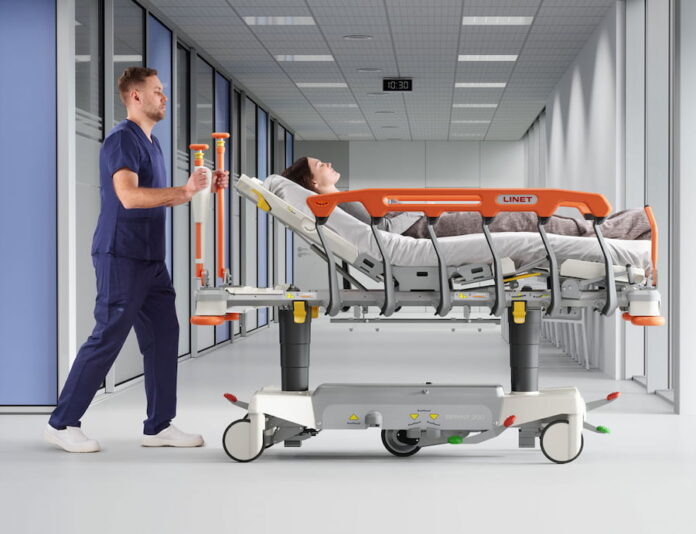In the fast-paced world of healthcare, the seamless transfer of patients between facilities ensures the best medical outcomes. However, there is far more to patient transfers than simply wheeling them into an ambulance and dropping them off at a different medical facility.
Transfers typically involve several entities other than the patient and, as a result, they can be surprisingly complex. Things can become even more complicated if the patient has special needs that have to be considered during and immediately after the transport process. Additionally, a lot of paperwork needs to be filled out to ensure payment and to make sure that each patient gets the care they need.
Patient transfer request workflows can vary significantly between facilities and are occasionally done in an ad hoc manner. With so many potential complications, transfers could often be slow and tedious, particularly when facilitated by inexperienced teams or ones that are not specifically trained in process optimization.
Partnering with a professional transport provider offers healthcare facilities and patients well-defined and efficient transfer request workflows. In this short guide, we’ll outline the basic steps of an ideal patient transfer request workflow, highlighting how it facilitates seamless patient transfers and improves the quality of care.
1) Staff Requests Transport
Rather than paper forms, professional transportation services will usually have some type of software or a patient transfer solution in place to track and request transports. If the facility has a patient transfer solution, the staff can login to the provider’s online portal to fill out a short questionnaire to inform the transport provider about the patient and their special transport requirements. Once the questionnaire is filled out and confirmed, the next step of the process may begin automatically.
Without the patient transfer solution, the staff will need to get in touch with their in-house ambulance team or with other service providers by phone. If the in-house team or the provider they call does not have suitable transport available, the staff will need to either wait for a vehicle, make compromises on the transport option, or call another provider. In all cases, delays can occur that result in a potential risk to the patient and further inconvenience down the line.
2) Transport Service Accepts Request
Once the questionnaire is complete, the patient transfer solution will typically send out notifications to transport providers through text and email. If a transport provider accepts the request, the staff will be immediately notified. If there are no vehicles available, the ride will be automatically queued to receive the next available transport, minimizing the need for phone calls to explain the situation.
In traditional patient transport workflows, all these processes will be handled manually, if at all. Because providers may have to handle multiple requests at a time, some patients may not get the priority that they need.
3) Paperwork Is Completed Automatically
Transportation service providers will use the information on submitted questionnaires to automatically fill out all the needed electronic forms, including Medical Necessity or Physician Certification forms. This minimizes clerical errors as well as the need for transport stakeholders to rewrite or retype the same information. This results in much better data accuracy and prevents payment from delay.
In typical workflows, everyone involved in the transfer may have to fill out various forms, which often times gets neglected. This uses up precious minutes that should, instead, be used for patient care and transportation. Additionally, this process is error-prone and occasionally disregarded, leaving the patient at risk from medical care errors.
4) Real-Time Updates Are Given to All Parties
The best medical transportation solution typically has systems that send real-time status updates to everyone involved in a patient’s transport. Updates can be sent not only to the drivers and crew directly involved in the patient’s care, but also to the staff at receiving facilities, the patient’s family members, and the patient themselves. This makes the entire process completely transparent and reduces the delays that would have otherwise been created by different stakeholders having to contact each other.
In contrast, sending out updates following the traditional workflow is much slower, requiring different parties to constantly interface with each other. As a result, updates are often inaccurate or non-existent, with no single person fully understanding all of the specifics of a patient’s case. This lack of transparency can cause delays and errors that may put the patient at serious risk.
While there may be some slight differences, the best transport providers generally follow the steps above, as this automated workflow can shave off minutes, if not hours, of waiting time. Taking a wider view, these workflows benefit everyone who needs medical transport within the service area. Ultimately, following a workflow similar to what’s described allows crews to spend more time transporting patients and less time getting bogged down in paperwork.
Most importantly, these systems also lead to better patient outcomes. With less time spent waiting for transport, patients with critical or delicate conditions have a better chance of receiving critical care on time. By partnering with a professional transport provider that understands workflow management, healthcare facilities can confidently elevate the standard of care that their patients receive.
Read Also
- Management Reinforcement for Healthcare Providers in a Shifting SystemHealthcare is changing faster than ever. So, providers are feeling the pressure to keep up. New technology, changing patient needs, and constant rule updates make it tough for managers to stay on top. Strong leadership helps teams work better, give great care, and stay happy in their jobs. Here’s how healthcare leaders can strengthen their… Read more: Management Reinforcement for Healthcare Providers in a Shifting System
- Why Effective Disinfection Remains the Foundation of Public HealthFrom hospitals and schools to transport hubs and food production sites, disinfection is central to breaking the chain of infection and protecting community health. The COVID-19 pandemic highlighted how crucial surface hygiene and environmental control are in reducing the spread of harmful microorganisms. Yet, beyond emergency response, routine and validated disinfection practices remain the cornerstone… Read more: Why Effective Disinfection Remains the Foundation of Public Health
- How to Navigate Your Medical Assistant Career PathBecoming a medical assistant can feel both exciting and a little stressful. This job lets you work closely with doctors and other healthcare workers to help patients. But with so many different paths to take, it can be hard to know where to start or how to plan your career. Wouldn’t it be nice to… Read more: How to Navigate Your Medical Assistant Career Path
- Benefits of Enrolling in Botox Training CoursesMany people want to enhance their skills in the beauty field, and one way to do that is through Botox training. With the rising popularity of Botox, enrolling in training courses can set you on a path to a rewarding career. If you are considering this option, you might be curious about the benefits that… Read more: Benefits of Enrolling in Botox Training Courses
- How Pilates Certification Enhances Professional Growth in HealthcareAre you looking for a way to expand your skills and stand out in healthcare? Pilates certification can be a powerful step in your professional journey. It not only helps you understand movement and body mechanics. It also gives you tools to support patient recovery. It also improves mobility, and promotes wellness. Ready to see… Read more: How Pilates Certification Enhances Professional Growth in Healthcare
- Understanding the Legality & Challenges in the Dental Aligner IndustryThe dental aligner industry has grown quickly in the past decade. More people are choosing clear aligners instead of traditional braces because they are less noticeable and often more convenient. While this growth has created new opportunities, it has also raised legal questions and practical challenges. Patients, dentists, and companies are still learning how to… Read more: Understanding the Legality & Challenges in the Dental Aligner Industry
- CPR Skills: Be Ready to Act When It Matters MostEvery year, many emergencies happen where lives are at risk and quick action is needed. One skill that can make a big difference is knowing CPR (cardiopulmonary resuscitation) and first aid. In these moments, knowing what to do can be the difference between life and death. By learning these skills, you protect yourself and become… Read more: CPR Skills: Be Ready to Act When It Matters Most








